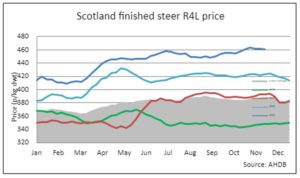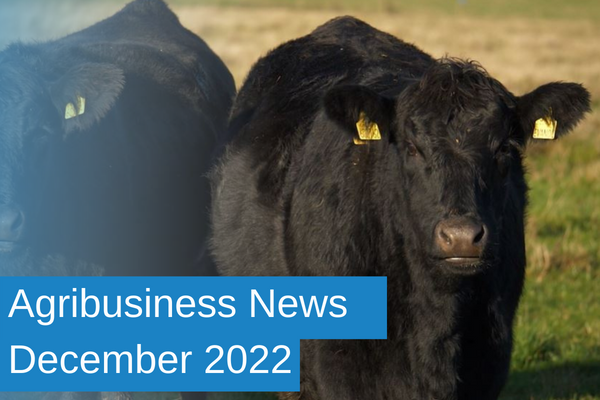Agribusiness News December 2022 – Beef
1 December 2022Prime cattle price eases backwards
A lift in prime cattle prices last month as processors looked to secure enough prime cattle to fulfil Christmas orders was short lived. Finished prices have started to ease over the past weeks, due to processors nearing half way through their Christmas kill. For week ended 19th Nov the R4L price for Scotland was 461p/kg. This is likely to drop further in the coming weeks as processors report slow demand (beef sale volumes continue to be down on the year – the only beef seeing growth in volume is mince) and switch back to killing more cows each week.
In line with seasonality, as processors focus on prime cattle for their Christmas kill, cull cow prices have fallen back in recent weeks, although prices are still substantially higher than this time last year and above the 5-year average. However demand remains strong for cows which is likely to continue into the New Year, as following Christmas consumers will look to make cost savings, turning to cheaper cuts after the Christmas spend in addition to the pressures of the cost of living crisis.
The cost-of-living crisis is also affecting cattle hide prices as retail sales of finished leather have slowed reportedly linked to economic pressures. UK cattle hide prices over the past few weeks have continued to fall, with tanners affected by rising processing costs, in particular, energy, labour and chemicals. The concern now is that slaughter rates may increase over the winter, as cattle finishers contend with the pressures of high feed costs.
Store cattle
Store cattle prices have also generally eased over recent weeks, with the leaner, lighter types being met with resistance, due to finishers mindful of the longer keep time and cost to feed these types.
Although feed prices have eased from pre-harvest highs, tight supplies are keeping prices supported as we enter winter peak demand. Quality prevails in the store ring with well-bred suckled calves, with good bone and shape and good weights for their age continuing to sell well. With such a strong trade for suckled calves, many farmers have chosen to sell more calves this backend as farmer margins continue to feel the pressure of high input costs.
Looking ahead to 2023
Food security remains a concern for the industry, the Covid-19 pandemic, the fallout from Brexit and the impact of Russia’s invasion of Ukraine have placed greater strain on both domestic and global food supply chains. The UK is barely 60% self-sufficient in food production and all this comes at a time when the agricultural industry is at a crossroads. Farmers are under pressure to tackle climate change while being faced with challenging economics with input costs remaining significantly higher than last year.
There may have to be some tough decisions made in 2023, with the continuing pressures of feed, fuel and fertiliser price hikes all taking their toll on businesses. We are still no further forward with policy and future support which only adds further to the uncertainties of what lies ahead.
sarah.balfour@sac.co.uk, 01307 464033
Sign up to the FAS newsletter
Receive updates on news, events and publications from Scotland’s Farm Advisory Service



